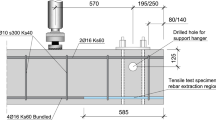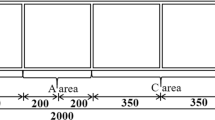Abstract
The combined effects of corrosion and fatigue have become a topic issue in recent times. Decades-old steel bridges that are still in service need to be reassessed. However, there is no relevant background information that can be used in assessment of this phenomenon. There are no recommendations for civil engineers how to take into account the corrosion weakening for the assessment of bearing capacity and fatigue strength of riveted members. For this reason the aim of the research presented in this paper was preparation and execution of laboratory tests on real bridge components that were deteriorated by corrosion. Two types of tests were performed to find out how corrosion weakening affects the statics and the fatigue strength of members. The evaluation of the tests indicates that the service life of members may be significantly reduced due to fatigue. In addition, the bearing capacity is reduced while, in particular, the local stress rises. All of this is strongly dependent on the level of corrosion and the surface irregularities. Our paper ends with recommendations on how the loss of material due to corrosion could be taken into account for an assessment of the load capacity and the residual lifetime of members.



























Similar content being viewed by others
References
Beaulieu, L. V., Legeron, F., & Langlois, S. (2010). Compression strength of corroded steel angle members. Journal of Constructional Steel Research, 66(11), 1366–1373.
Chen, Y., Li, X., Chai, Y. H., & Zhou, J. (2010). Assessment of the flexural capacity of corroded steel pipes. International Journal of Pressure Vessels and Piping, 87(2), 100–110.
ČSN EN ISO 13822. (2005). Bases for design of structures—assessment of existing structures, CNI Praha.
Di Battista, J. D., Adamson, D. E., & Kulak, G. L. (1998). Fatigue strength of riveted connections. Journal of Structural Engineering, 124(7), 792–797.
Feldmann, M., Heinemeyer, C., & Hinrichs, H. (2008). Zum Einfluss der Nietkopfabrostung auf die Nietvorspannung und Dauerhaftigkeit alter Stahlkonstruktionen. Bautechnik, 85(2), 93–102.
Garbatov, Y., Soares, C. G., & Parunov, J. (2014). Fatigue strength experiments of corroded small scale steel specimens. International Journal of Fatigue, 59, 137–144.
Heinemeyer, C., & Feldmann, M. (2011). The influence of rivet corrosion on the durability of riveted connections. Steel Construction, 4(3), 188–192.
Huang, W., Garbatov, Y., & Guedes Soares, C. (2014). Fatigue reliability of a web frame subjected to random non-uniform corrosion wastage. Structural Safety, 48((Supplement C)), 51–62.
Kaita, T., Appuhamy, J. M. R. S., Itogawa, K., Ohga, M., & Fujii, K. (2011). Experimental study on remaining strength estimation of corroded wide steel plates under tensile force. Procedia Engineering, 14, 2707–2713.
Kayser, J. R., & Nowak, A. S. (1989). Reliability of corroded steel girder bridges. Structural Safety, 6(1), 53–63.
Koteš, P., & Vičan, J. (2012). Reliability levels for existing bridges evaluation according to eurocodes. Procedia Engineering, 40, 211–216.
Nakai, T., Matsushita, H., & Yamamoto, N. (2006). Effect of pitting corrosion on the ultimate strength of steel plates subjected to in-plane compression and bending. Journal of Marine Science and Technology, 11(1), 52–64.
Palin-Luc, T., Pérez-Mora, R., Bathias, C., Domínguez, G., Paris, P. C., & Arana, J. L. (2010). Fatigue crack initiation and growth on a steel in the very high cycle regime with sea water corrosion. Engineering Fracture Mechanics, 77(11), 1953–1962.
Pipinato, A., Pellegrino, C., Bursi, O. S., & Modena, C. (2009). High-cycle fatigue behavior of riveted connections for railway metal bridges. Journal of Constructional Steel Research, 65(12), 2167–2175.
Rahbar-Ranji, A. (2012). Ultimate strength of corroded steel plates with irregular surfaces under in-plane compression. Ocean Engineering, 54((Supplement C)), 261–269.
Rahgozar, R., & Sharifi, Y. (2011). Remaining fatigue life of corroded steel structural members. Advances in Structural Engineering, 14(5), 881–890.
Ryjáček, P., Macho, M., Stančík, V., & Polák, M. (2016). Deterioration and assessment of steel bridges. In Maintenance, monitoring, safety, risk and resilience of bridges and bridge networks - Proceedings of the 8th international conference on bridge maintenance, safety and management, IABMAS 2016 (pp. 1188–1195).
Sharifi, Y., & Rahgozar, R. (2010). Remaining moment capacity of corroded steel beams. International Journal of Steel Structures, 10(2), 165–176.
Silva, J. E., Garbatov, Y., & Guedes Soares, C. (2014). Reliability assessment of a steel plate subjected to distributed and localized corrosion wastage. Engineering Structures, 59((Supplement C)), 13–20.
Tran Nguyen, K., Garbatov, Y., & Guedes Soares, C. (2012). Fatigue damage assessment of corroded oil tanker details based on global and local stress approaches. International Journal of Fatigue, 43((Supplement C)), 197–206.
Xu, S., & Qiu, B. (2013). Experimental study on fatigue behavior of corroded steel. Materials Science and Engineering: A, 584((Supplement C)), 163–169.
Xu, S., & Wang, Y. (2015). Estimating the effects of corrosion pits on the fatigue life of steel plate based on the 3D profile. International Journal of Fatigue, 72((Supplement C)), 27–41.
UIC 778-2 R. (2016). Recommendations for determining the carrying capacity and fatigue risks of existing metal bridges - draft, UIC 2016.
Zahrai, S. M. (2003). Cyclic strength and ductility of rusted steel members. Asian Journal of Civil Engineering, 4(2–4), 135–148.
Zhang, X.-Y., Li, S.-X., Liang, R., & Akid, R. (2013). Effect of corrosion pits on fatigue life and crack initiation. In 13th International conference on fracture. Beijing, China.
Acknowledgements
This contribution was supported by the NAKI II project of the Ministry of Culture of the Czech Republic “The methods for achieving the sustainability of industrial heritage steel bridges” (No. DG18P02OVV033).
Author information
Authors and Affiliations
Corresponding author
Rights and permissions
About this article
Cite this article
Macho, M., Ryjáček, P. & Matos, J.C.e. Static and Fatigue Test on Real Steel Bridge Components Deteriorated by Corrosion. Int J Steel Struct 19, 110–130 (2019). https://doi.org/10.1007/s13296-018-0099-6
Received:
Accepted:
Published:
Issue Date:
DOI: https://doi.org/10.1007/s13296-018-0099-6




